Vennesla
Vennesla is a municipality in Agder county, Norway. It is located in the traditional district of Sørlandet. The administrative centre of the municipality is the village of Vennesla. Other villages in Vennesla include Grovane, Hægeland, Homstean, Mushom, Øvre Eikeland, Øvrebø, Røyknes, and Skarpengland. Vennesla lies about 17 kilometres (11 mi) north of the city of Kristiansand in the Otra river valley.
Vennesla kommune | |
|---|---|
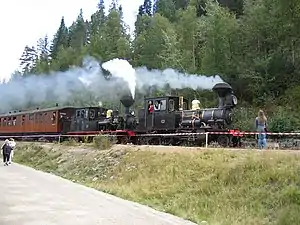 View of the Setesdal Line railway museum in Vennesla municipality | |
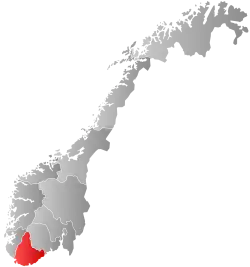 Agder within Norway | |
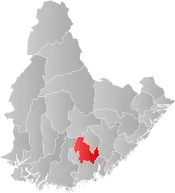 Vennesla within Agder | |
| Coordinates: 58°18′38″N 7°51′25″E | |
| Country | Norway |
| County | Agder |
| District | Sørlandet |
| Established | 1864 |
| • Preceded by | Øvrebø Municipality |
| Administrative centre | Vennesla |
| Government | |
| • Mayor (2017) | Nils Olav Larsen (KrF) |
| Area | |
| • Total | 384.49 km2 (148.45 sq mi) |
| • Land | 362.06 km2 (139.79 sq mi) |
| • Water | 22.43 km2 (8.66 sq mi) 5.8% |
| • Rank | #242 in Norway |
| Population (2022) | |
| • Total | 15,123 |
| • Rank | #78 in Norway |
| • Density | 41.8/km2 (108/sq mi) |
| • Change (10 years) | |
| Demonym | Venndøl[1] |
| Official language | |
| • Norwegian form | Neutral |
| Time zone | UTC+01:00 (CET) |
| • Summer (DST) | UTC+02:00 (CEST) |
| ISO 3166 code | NO-4223 |
| Website | Official website |
The 384-square-kilometre (148 sq mi) municipality is the 242nd largest by area out of the 356 municipalities in Norway. Vennesla is the 78th most populous municipality in Norway with a population of 15,123. The municipality's population density is 41.8 inhabitants per square kilometre (108/sq mi) and its population has increased by 11.3% over the previous 10-year period.[3][4]
General information
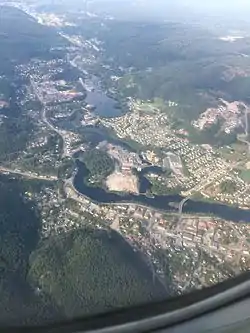
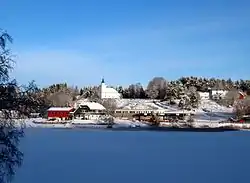
The parish of Vennesla was established as a municipality in 1864 when it was separated from the larger municipality of Øvrebø. Initially, Vennesla had 1,103 residents. During the 1960s, there were many municipal mergers across Norway due to the work of the Schei Committee. On 1 January 1964, Vennesla (population: 7,321) was merged with most of the neighboring municipality of Øvrebø (population: 925) and with all of another neighboring municipality, Hægeland (population: 849) which created a new, much larger municipality of Vennesla. On 1 January 1978, a small area of Vennesla (population: 10) was transferred to neighboring Songdalen municipality. Then again on 1 January 1984, the unpopulated Hauglandsvatnet area was transferred from Vennesla to Songdalen municipality. On 1 January 1990, the unpopulated Røssebrekka area, just east of the village of Vennesla was transferred from Kristiansand municipality to Vennesla.[5]
Name
The municipality (originally the parish) is named after the old Vennesla farm (Old Norse: Vendilslá) since the first Vennesla Church was built there. The first element is vendil which comes from the word vǫndr which means "small twig". This may have been an old name for an arm of Venneslafjorden. The last element is lá which means "swamp" or "shallow water".[6]
Coat of arms
The coat of arms was adopted on 15 May 1971. The blazon is "Gules, three barrulets wavy in bend sinister with six tree trunks with branches issuant in chief and two cogwheels in sinister base Or". This means the arms have a red field (background) and the charge is three wavy lines diagonally crossing the arms with six trees above the lines and two cogwheels below. The charge has a tincture of Or which means it is commonly colored yellow, but if it is made out of metal, then gold is used. The three wavy lines symbolises the river Otra, which runs through the municipality. The six trees symbolize the importance of forestry to the local economy. The cogwheels symbolize the local industry. There is a three-pointed mural crown on top of the arms which represent the three municipalities that were merged in 1964 to form the present municipality: Vennesla, Øvrebø, and Hægeland. The arms were designed by Alv Erikstad. The municipal flag has the same design as the coat of arms.[7][8][9]
Churches
The Church of Norway has three parishes (sokn) within the municipality of Vennesla. It is part of the Otredal deanery in the Diocese of Agder og Telemark.
| Parish (sokn) | Church name | Location of the church | Year built |
|---|---|---|---|
| Hægeland | Hægeland Church | Hægeland | 1830 |
| Vennesla | Vennesla Church | Vennesla | 1829 |
| Øvrebø | Øvrebø Church | Øvrebø | 1800 |
Government
All municipalities in Norway are responsible for primary education (through 10th grade), outpatient health services, senior citizen services, welfare and other social services, zoning, economic development, and municipal roads and utilities. The municipality is governed by a municipal council of directly elected representatives. The mayor is indirectly elected by a vote of the municipal council.[10] The municipality is under the jurisdiction of the Agder District Court and the Agder Court of Appeal.
Municipal council
The municipal council (Kommunestyre) of Vennesla is made up of 27 representatives that are elected to four year terms. The tables below show the current and historical composition of the council by political party.
| Party Name (in Norwegian) | Number of representatives | |
|---|---|---|
| Labour Party (Arbeiderpartiet) | 5 | |
| Progress Party (Fremskrittspartiet) | 3 | |
| Conservative Party (Høyre) | 3 | |
| The Christians Party (Partiet De Kristne) | 1 | |
| Christian Democratic Party (Kristelig Folkeparti) | 8 | |
| Centre Party (Senterpartiet) | 6 | |
| Socialist Left Party (Sosialistisk Venstreparti) | 1 | |
| Total number of members: | 27 | |
| Party Name (in Norwegian) | Number of representatives | |
|---|---|---|
| Labour Party (Arbeiderpartiet) | 7 | |
| Progress Party (Fremskrittspartiet) | 3 | |
| Conservative Party (Høyre) | 3 | |
| The Christians Party (Partiet De Kristne) | 1 | |
| Christian Democratic Party (Kristelig Folkeparti) | 8 | |
| Centre Party (Senterpartiet) | 4 | |
| Liberal Party (Venstre) | 1 | |
| Total number of members: | 27 | |
| Party Name (in Norwegian) | Number of representatives | |
|---|---|---|
| Labour Party (Arbeiderpartiet) | 8 | |
| Progress Party (Fremskrittspartiet) | 4 | |
| Conservative Party (Høyre) | 4 | |
| Christian Democratic Party (Kristelig Folkeparti) | 8 | |
| Centre Party (Senterpartiet) | 2 | |
| Liberal Party (Venstre) | 1 | |
| Total number of members: | 27 | |
| Party Name (in Norwegian) | Number of representatives | |
|---|---|---|
| Labour Party (Arbeiderpartiet) | 7 | |
| Progress Party (Fremskrittspartiet) | 7 | |
| Conservative Party (Høyre) | 2 | |
| Christian Democratic Party (Kristelig Folkeparti) | 9 | |
| Centre Party (Senterpartiet) | 2 | |
| Total number of members: | 27 | |
| Party Name (in Norwegian) | Number of representatives | |
|---|---|---|
| Labour Party (Arbeiderpartiet) | 8 | |
| Progress Party (Fremskrittspartiet) | 5 | |
| Conservative Party (Høyre) | 2 | |
| Christian Democratic Party (Kristelig Folkeparti) | 8 | |
| Centre Party (Senterpartiet) | 2 | |
| Socialist Left Party (Sosialistisk Venstreparti) | 2 | |
| Total number of members: | 27 | |
| Party Name (in Norwegian) | Number of representatives | |
|---|---|---|
| Labour Party (Arbeiderpartiet) | 9 | |
| Progress Party (Fremskrittspartiet) | 5 | |
| Conservative Party (Høyre) | 3 | |
| Christian Democratic Party (Kristelig Folkeparti) | 12 | |
| Centre Party (Senterpartiet) | 3 | |
| Socialist Left Party (Sosialistisk Venstreparti) | 2 | |
| Liberal Party (Venstre) | 1 | |
| Total number of members: | 35 | |
| Party Name (in Norwegian) | Number of representatives | |
|---|---|---|
| Labour Party (Arbeiderpartiet) | 12 | |
| Progress Party (Fremskrittspartiet) | 3 | |
| Conservative Party (Høyre) | 2 | |
| Christian Democratic Party (Kristelig Folkeparti) | 13 | |
| Centre Party (Senterpartiet) | 3 | |
| Socialist Left Party (Sosialistisk Venstreparti) | 1 | |
| Liberal Party (Venstre) | 1 | |
| Total number of members: | 35 | |
| Party Name (in Norwegian) | Number of representatives | |
|---|---|---|
| Labour Party (Arbeiderpartiet) | 14 | |
| Progress Party (Fremskrittspartiet) | 2 | |
| Conservative Party (Høyre) | 2 | |
| Christian Democratic Party (Kristelig Folkeparti) | 11 | |
| Centre Party (Senterpartiet) | 4 | |
| Socialist Left Party (Sosialistisk Venstreparti) | 2 | |
| Total number of members: | 35 | |
| Party Name (in Norwegian) | Number of representatives | |
|---|---|---|
| Labour Party (Arbeiderpartiet) | 16 | |
| Progress Party (Fremskrittspartiet) | 3 | |
| Conservative Party (Høyre) | 3 | |
| Christian Democratic Party (Kristelig Folkeparti) | 9 | |
| Centre Party (Senterpartiet) | 2 | |
| Socialist Left Party (Sosialistisk Venstreparti) | 1 | |
| Liberal Party (Venstre) | 1 | |
| Total number of members: | 35 | |
| Party Name (in Norwegian) | Number of representatives | |
|---|---|---|
| Labour Party (Arbeiderpartiet) | 17 | |
| Progress Party (Fremskrittspartiet) | 1 | |
| Conservative Party (Høyre) | 4 | |
| Christian Democratic Party (Kristelig Folkeparti) | 10 | |
| Centre Party (Senterpartiet) | 2 | |
| Socialist Left Party (Sosialistisk Venstreparti) | 1 | |
| Total number of members: | 35 | |
| Party Name (in Norwegian) | Number of representatives | |
|---|---|---|
| Labour Party (Arbeiderpartiet) | 15 | |
| Conservative Party (Høyre) | 5 | |
| Christian Democratic Party (Kristelig Folkeparti) | 9 | |
| Liberal People's Party (Liberale Folkepartiet) | 1 | |
| Centre Party (Senterpartiet) | 3 | |
| Socialist Left Party (Sosialistisk Venstreparti) | 1 | |
| Liberal Party (Venstre) | 1 | |
| Total number of members: | 35 | |
| Party Name (in Norwegian) | Number of representatives | |
|---|---|---|
| Labour Party (Arbeiderpartiet) | 15 | |
| Conservative Party (Høyre) | 2 | |
| Christian Democratic Party (Kristelig Folkeparti) | 10 | |
| New People's Party (Nye Folkepartiet) | 2 | |
| Centre Party (Senterpartiet) | 4 | |
| Socialist Left Party (Sosialistisk Venstreparti) | 1 | |
| Liberal Party (Venstre) | 1 | |
| Total number of members: | 35 | |
| Party Name (in Norwegian) | Number of representatives | |
|---|---|---|
| Labour Party (Arbeiderpartiet) | 17 | |
| Conservative Party (Høyre) | 1 | |
| Christian Democratic Party (Kristelig Folkeparti) | 6 | |
| Centre Party (Senterpartiet) | 4 | |
| Liberal Party (Venstre) | 5 | |
| Socialist common list (Venstresosialistiske felleslister) | 2 | |
| Total number of members: | 35 | |
| Party Name (in Norwegian) | Number of representatives | |
|---|---|---|
| Labour Party (Arbeiderpartiet) | 18 | |
| Conservative Party (Høyre) | 1 | |
| Christian Democratic Party (Kristelig Folkeparti) | 5 | |
| Centre Party (Senterpartiet) | 3 | |
| Socialist People's Party (Sosialistisk Folkeparti) | 2 | |
| Liberal Party (Venstre) | 6 | |
| Total number of members: | 35 | |
| Party Name (in Norwegian) | Number of representatives | |
|---|---|---|
| Labour Party (Arbeiderpartiet) | 19 | |
| Conservative Party (Høyre) | 1 | |
| Christian Democratic Party (Kristelig Folkeparti) | 4 | |
| Centre Party (Senterpartiet) | 3 | |
| Socialist People's Party (Sosialistisk Folkeparti) | 2 | |
| Liberal Party (Venstre) | 6 | |
| Total number of members: | 35 | |
| Party Name (in Norwegian) | Number of representatives | |
|---|---|---|
| Labour Party (Arbeiderpartiet) | 13 | |
| Communist Party (Kommunistiske Parti) | 1 | |
| Christian Democratic Party (Kristelig Folkeparti) | 3 | |
| Centre Party (Senterpartiet) | 1 | |
| Liberal Party (Venstre) | 5 | |
| Total number of members: | 23 | |
| Party Name (in Norwegian) | Number of representatives | |
|---|---|---|
| Labour Party (Arbeiderpartiet) | 13 | |
| Communist Party (Kommunistiske Parti) | 2 | |
| Christian Democratic Party (Kristelig Folkeparti) | 3 | |
| Farmers' Party (Bondepartiet) | 1 | |
| Liberal Party (Venstre) | 4 | |
| Total number of members: | 23 | |
| Party Name (in Norwegian) | Number of representatives | |
|---|---|---|
| Labour Party (Arbeiderpartiet) | 12 | |
| Communist Party (Kommunistiske Parti) | 2 | |
| Christian Democratic Party (Kristelig Folkeparti) | 2 | |
| Liberal Party (Venstre) | 4 | |
| Total number of members: | 20 | |
| Party Name (in Norwegian) | Number of representatives | |
|---|---|---|
| Labour Party (Arbeiderpartiet) | 9 | |
| Communist Party (Kommunistiske Parti) | 2 | |
| Joint list of the Liberal Party (Venstre) and the Radical People's Party (Radikale Folkepartiet) | 5 | |
| Total number of members: | 16 | |
| Party Name (in Norwegian) | Number of representatives | |
|---|---|---|
| Labour Party (Arbeiderpartiet) | 9 | |
| Communist Party (Kommunistiske Parti) | 2 | |
| Joint list of the Liberal Party (Venstre) and the Radical People's Party (Radikale Folkepartiet) | 5 | |
| Total number of members: | 16 | |
| Party Name (in Norwegian) | Number of representatives | |
|---|---|---|
| Labour Party (Arbeiderpartiet) | 11 | |
| Liberal Party (Venstre) | 5 | |
| Total number of members: | 16 | |
| Note: Due to the German occupation of Norway during World War II, no elections were held for new municipal councils until after the war ended in 1945. | ||
Mayors
The mayors (Norwegian: ordfører) of Vennesla:[29]
1864–1866: Nils Robstad 1867–1868: Even S. Drivenes 1869–1876: T.A. Vennesland 1877–1880: Nils Robstad (V) 1881–1884: Endre Moseid (V) 1885–1890: Nils Robstad (V) 1891–1898: Endre Moseid (MV) 1899–1902: Salve N. Robstad (V) 1903–1905: Endre Moseid (V) 1906–1908: Olaf Vennesland (V) 1909–1911: Askild Røskeland (V) 1912–1914: Olaf Vennesland (V) 1915–1920: A.T. Askedal (Ap) 1921–1923: Gabriel Moseid (Bp) 1924–1929: Anders S. Robstad (Ap) 1930–1941: Jørgen A. Robstad (Ap) 1945-1945: Jørgen A. Robstad (Ap) 1946–1954: Ole Jørgensen (Ap) 1954–1957: Sverre Vennesland (Ap) 1958–1959: Otto Heiseldal (Ap) 1960–1973: Engly Lie (Ap) 1974–1975: Tore Robstad (Ap) 1976–1983: Ragnar Krogstad (KrF) 1984–1989: Tore Robstad (Ap) 1990–1999: John Edvard Olsen (KrF) 1999–2017: Torhild Bransdal (KrF) 2017–present: Nils Olav Larsen (KrF)
Geography
Vennesla municipality is situated in Agder county, Norway, about 17 kilometres (11 mi) north of the city of Kristiansand. The neighboring municipalities are Evje og Hornnes (to the north), Birkenes and Iveland (to the east), and Kristiansand (to the south and west), and Lindesnes (to the west).
The river Otra runs through the municipality from north to south. Both of the lakes Kilefjorden and Venneslafjorden are located along the river. The river Songdalselva runs through the western part of the municipality.
Climate
| Climate data for Vennesla | |||||||||||||
|---|---|---|---|---|---|---|---|---|---|---|---|---|---|
| Month | Jan | Feb | Mar | Apr | May | Jun | Jul | Aug | Sep | Oct | Nov | Dec | Year |
| Daily mean °C (°F) | −2.0 (28.4) |
−2.1 (28.2) |
0.8 (33.4) |
4.5 (40.1) |
10.0 (50.0) |
14.2 (57.6) |
15.7 (60.3) |
15.0 (59.0) |
11.5 (52.7) |
8.0 (46.4) |
2.8 (37.0) |
−0.4 (31.3) |
6.5 (43.7) |
| Average precipitation mm (inches) | 126 (5.0) |
82 (3.2) |
89 (3.5) |
58 (2.3) |
85 (3.3) |
73 (2.9) |
86 (3.4) |
115 (4.5) |
143 (5.6) |
169 (6.7) |
160 (6.3) |
119 (4.7) |
1,305 (51.4) |
| Source: Norwegian Meteorological Institute[30] | |||||||||||||
Economy
Vennesla (mostly the village of Vennesla) has a small industrial base, primarily with Hunsfos Fabrikker AS, a paper mill, as the cornerstone of the community. During recent decades, however, the number of employees has drastically declined from around 1,200 in the 1970s, to 200 in 2005 and 120 in 2007. In 2010 there was only 135 employees at the paper mill. In 2011, Hunsfos Fabrikker AS celebrated 125 years as a paper mill but later the same year finally ceased production and was declared bankrupt..[31]
During Q4 2022, "one hundred plus" workers at Huntonit, a cornerstone[32] of the community, were scheduled for a temporary Layoff (from work); that's a large part of the company's work force; there is no fixed schedule for returning to work.
Media
The newspaper Vennesla Tidende has been published in Vennesla since 1989.[33]
Attractions
Vikeland Hovedgård
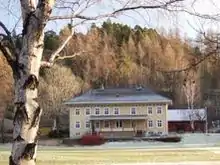
Vikeland Hovedgård is a manor house located along the Otra River in the village of Vennesla. Vigeland Manor was completed in 1847. The building was constructed of wood in both Empire and Swiss style. It was built as part of Vigeland Brug, then one of the largest sawmills in the area. Vigeland Manor was built by Caspar Wild who bought the farm and adjacent sawmill in 1833. In 1894, the farm was sold to John Clarke Hawkshaw whose family retained the manor until around 1960. The current annex was built around 1900. During the 1980s, there was restoration with the main building subsequently used as lodging, corporate, and meeting facilities.[34]
The manor house has been said to be haunted by a ghost known as "the Blue Lady" (den Blå Dama). Mari was a farm worker who fell in love with the owner's son. They were not allowed to marry, so it is said Mari committed suicide in the "blue room", hence the title "the Blue Lady".[35]
Vennesla Church
Vennesla Church (Vennesla Kirke) serves Vennesla parish in Otredal deanery (Otredal prosti). The church was completed in 1829 and consecrated the following year. The church was built of stone and brick, while the west tower with side buildings are wooden. The church replaced a church from the first half of the 1600s. The tower was made higher in 1886, and the interior was restored in 1925.
Vindbjart Football Club
The football club of Vennesla is Vindbjart FK, founded in 1896. Vindbjart is currently playing in the Norwegian Second Division and the stadium is Moseidmoen gress in the village of Vennesla.
Notable people

- Gabriel Moseid (1882 in Vennesla – 1961), a politician who was Mayor of Vennesla in 1922
- Ole Jørgensen (1897–1966), a Norwegian politician and Mayor of Vennesla during the 1940s & 1950s
- Sigurd Aalefjær (1917–1991), an engineer and director of hydropower plants who grew up in Vennesla
- Engly Lie (1919 in Vennesla – 2001), a carpenter and politician who was Mayor of Vennesla in 1959
- Børre Knudsen (1937 in Vennesla – 2014), a Lutheran priest and anti-abortion activist[36]
- Kristen Gislefoss (born 1954 in Vennesla), a meteorologist, prime time weather presenter for NRK
- Kjetil Nordhus (born 1975 in Vennesla), a Norwegian singer, composer, and music producer
- Jorun Stiansen (born 1984), a Norwegian pop singer and artist who grew up in Vennesla
- Maria Arredondo (born 1985 in Vennesla) a pop singer
Twin towns – sister cities
Vennesla is twinned with:
 Katrineholm, Sweden
Katrineholm, Sweden Odder, Denmark
Odder, Denmark Salo, Finland
Salo, Finland
See also
References
- "Navn på steder og personer: Innbyggjarnamn" (in Norwegian). Språkrådet.
- "Forskrift om målvedtak i kommunar og fylkeskommunar" (in Norwegian). Lovdata.no.
- Statistisk sentralbyrå. "Table: 06913: Population 1 January and population changes during the calendar year (M)" (in Norwegian).
- Statistisk sentralbyrå. "09280: Area of land and fresh water (km²) (M)" (in Norwegian).
- Jukvam, Dag (1999). "Historisk oversikt over endringer i kommune- og fylkesinndelingen" (PDF) (in Norwegian). Statistisk sentralbyrå. ISBN 9788253746845.
- Rygh, Oluf (1912). Norske gaardnavne: Lister og Mandals amt (in Norwegian) (9 ed.). Kristiania, Norge: W. C. Fabritius & sønners bogtrikkeri. p. 29.
- "Civic heraldry of Norway - Norske Kommunevåpen". Heraldry of the World. Retrieved 20 July 2023.
- "Kommunevåpen" (in Norwegian). Vennesla kommune. Retrieved 24 January 2017.
- "Vennesla kommune, våpen". Digitalarkivet (in Norwegian). Arkivverket. Retrieved 20 July 2023.
- Hansen, Tore; Vabo, Signy Irene, eds. (20 September 2022). "kommunestyre". Store norske leksikon (in Norwegian). Kunnskapsforlaget. Retrieved 14 October 2022.
- "Tall for Norge: Kommunestyrevalg 2019 – Agder". Valg Direktoratet. Retrieved 6 December 2020.
- "Table: 04813: Members of the local councils, by party/electoral list at the Municipal Council election (M)" (in Norwegian). Statistics Norway.
- "Tall for Norge: Kommunestyrevalg 2011 – Vest-Agder". Valg Direktoratet. Retrieved 6 December 2020.
- "Kommunestyrevalget 1995" (PDF) (in Norwegian). Oslo-Kongsvinger: Statistisk sentralbyrå. 1996. Retrieved 6 December 2020.
- "Kommunestyrevalget 1991" (PDF) (in Norwegian). Oslo-Kongsvinger: Statistisk sentralbyrå. 1993. Retrieved 6 December 2020.
- "Kommunestyrevalget 1987" (PDF) (in Norwegian). Oslo-Kongsvinger: Statistisk sentralbyrå. 1988. Retrieved 6 December 2020.
- "Kommunestyrevalget 1983" (PDF) (in Norwegian). Oslo-Kongsvinger: Statistisk sentralbyrå. 1984. Retrieved 6 December 2020.
- "Kommunestyrevalget 1979" (PDF) (in Norwegian). Oslo: Statistisk sentralbyrå. 1979. Retrieved 6 December 2020.
- "Kommunevalgene 1975" (PDF) (in Norwegian). Oslo: Statistisk sentralbyrå. 1977. Retrieved 6 December 2020.
- "Kommunevalgene 1972" (PDF) (in Norwegian). Oslo: Statistisk sentralbyrå. 1973. Retrieved 6 December 2020.
- "Kommunevalgene 1967" (PDF) (in Norwegian). Oslo: Statistisk sentralbyrå. 1967. Retrieved 6 December 2020.
- "Kommunevalgene 1963" (PDF) (in Norwegian). Oslo: Statistisk sentralbyrå. 1964. Retrieved 6 December 2020.
- "Kommunevalgene og Ordførervalgene 1959" (PDF) (in Norwegian). Oslo: Statistisk sentralbyrå. 1960. Retrieved 5 December 2020.
- "Kommunevalgene og Ordførervalgene 1955" (PDF) (in Norwegian). Oslo: Statistisk sentralbyrå. 1957. Retrieved 6 December 2020.
- "Kommunevalgene og Ordførervalgene 1951" (PDF) (in Norwegian). Oslo: Statistisk sentralbyrå. 1952. Retrieved 6 December 2020.
- "Kommunevalgene og Ordførervalgene 1947" (PDF) (in Norwegian). Oslo: Statistisk sentralbyrå. 1948. Retrieved 6 December 2020.
- "Kommunevalgene og Ordførervalgene 1945" (PDF) (in Norwegian). Oslo: Statistisk sentralbyrå. 1947. Retrieved 6 December 2020.
- "Kommunevalgene og Ordførervalgene 1937" (PDF) (in Norwegian). Oslo: Statistisk sentralbyrå. 1938. Retrieved 6 December 2020.
- Brunvatne, Olav; Njerve, Olav, eds. (1937). "Vennesla". Vest-Agder fylke 1837–1937 (in Norwegian). Kristiansand, Norge: Landmarks bokhandel. p. 554.
- "eKlima Web Portal". Norwegian Meteorological Institute. Archived from the original on 14 June 2004.
- "Hunsfos næringspark" (in Norwegian). Retrieved 24 January 2017.
- https://investor.dn.no/#!/Oversikt/Direkte/122935. Dagens Næringsliv.no. Retrieved 2022-11-04
- Store norske leksikon: Vennesla Tidende.
- "Vigeland hovedgård (Vigelands verk)". Kulturminnesøk. Retrieved 1 February 2016.
- "Historien til Vigeland hovedgård". Vigeland Hovedgård. Retrieved 1 February 2016.
- Kolberg, Marit; Ustad Stav, Torill (18 August 2014). "Børre Knudsen er død" (in Norwegian).
External links
 Media related to Vennesla at Wikimedia Commons
Media related to Vennesla at Wikimedia Commons The dictionary definition of Vennesla at Wiktionary
The dictionary definition of Vennesla at Wiktionary Vest-Agder travel guide from Wikivoyage
Vest-Agder travel guide from Wikivoyage- Municipal fact sheet from Statistics Norway (in Norwegian)
- Welcome to Vennesla – Tourist information
- Vigeland Hovedgård



